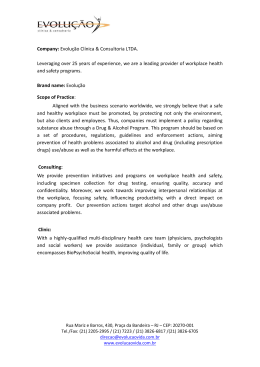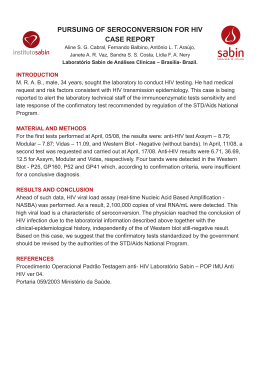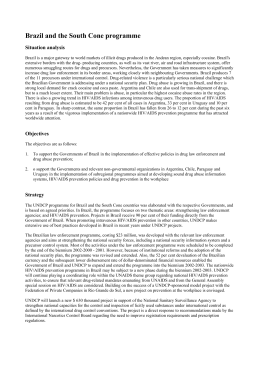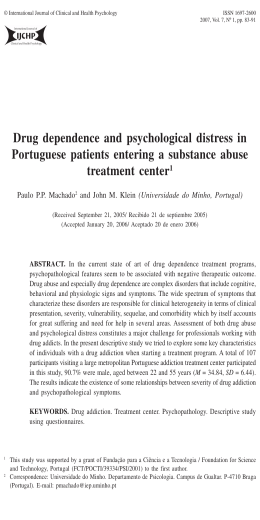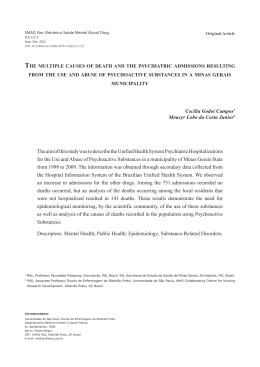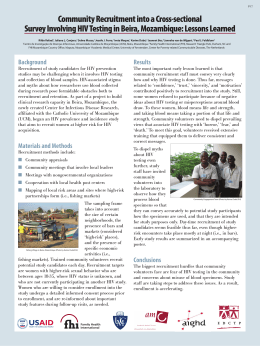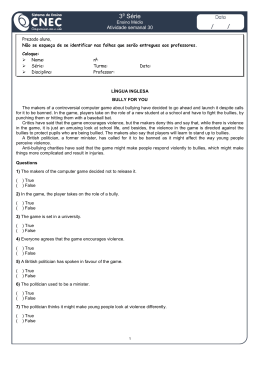Drugs, Women and Violence in the Americas: U.S. Quantitative Results of a Multi-Centric Pilot Project (Phase 2) Rosa María González-Guarda1 Nilda Peragallo2 Ami Lynch3 Susanna Nemes3 Abstract Objectives: To explore the collective and individual experiences that Latin American females in the U.S. have with substance abuse, violence and risky sexual behaviors. Methods: This study was conducted in two phases from July 2006 to June 2007 in south Florida. This paper covers Phase 2. In Phase 2, questionnaires were provided to women to test whether there is a relationship between demographics, acculturation, depression, self-esteem and substance use/abuse; whether there is a relationship between demographics, acculturation, depression, self-esteem and violence exposure and victimization; whether there is a relationship between demographics, acculturation, depression, self-esteem, HIV knowledge and STD and HIV/AIDS risks among respondents; and whether there is a relationship between substance abuse, violence victimization and HIV/AIDS risks among respondents. Results: Participants reported high rates of alcohol and drug abuse among their current or most recent partners. This is a major concern because partner alcohol use and drug use was related to partner physical, sexual and psychological abuse. Only two factors were associated with lifetime drug use: income and acculturation. Over half of the participants reported being victims of at least one form of abuse during childhood and adulthood. A substantial component of abuse reported during adulthood was perpetrated by a currently or recent intimate partner. Conclusions: The results from this study suggest that substance abuse, violence and HIV should be addressed in an integrative and comprehensive manner. Recommendations for the development of policies, programs and services addressing substance abuse, violence and risk for HIV among Latinos are provided. Key words: substance abuse, violence victimization, STDs, HIV, Hispanic, women Título: Drogas, mujeres y violencia en el continente americano: resultados de un proyecto piloto multicéntrico en Estados Unidos (Fase 2) Ph.D., M.PH., R.N., C.PH. School of Nursing and Health Studies, University of Miami. Coral Gables, FL, USA. 2 Dr PH, RN, FAAN. School of Nursing and Health Studies, University of Miami. Coral Gables, FL, USA. 3 Ph.D. Social Solutions International, Inc. Silver Spring, MD, USA. 1 66 S Rev. Colomb. Psiquiat., vol. 39, Suplemento 2010 Drugs, Women and Violence in the Americas: U.S. Quantitative Results of a Multi-Centric Pilot Project (Phase 2) Resumen Objetivo: Explorar las experiencias colectivas e individuales que mujeres latinomaericanas tienen en los Estados Unidos en cuanto al abuso de sustancias, violencia y conductas sexuales de riesgo. Métodos: El estudio se realizó en dos fases entre julio de 2006 y junio de 2007, en el sur de Florida. En la Fase 2, se dieron cuestionarios a las mujeres para comprobar si existe una relación entre: características demográficas, grado de aculturación, depresión, autoestima, uso/abuso de sustancias, exposición a la violencia y conocimiento de los riesgos del VIH y el sida. Resultados: Los participantes reportaron altos índices de abuso de alcohol y drogas. Sólo dos factores se asociaron con el uso de drogas de por vida: ingresos económicos y aculturación. Más de la mitad de los participantes informaron haber sido víctimas de al menos una forma de abuso (físico, sexual y/o psicológico) durante la infancia y la adultez. Un componente importante de los abusos reportados durante la edad adulta es que fueron perpetrados por un compañero íntimo. Conclusiones: Los resultados de este estudio sugieren que el abuso de sustancias, la violencia y el VIH deben abordarse de manera integradora y global. Palabras clave: trastornos relacionados con sustancias, violencia, enfermedades de transmisión sexual, VIH, mujeres. Introduction As the Hispanic/Latino population grows to 13.3% of the U.S. population, health needs for this population become increasingly important. The population is expected to continue to increase and the diversity of the Latino population needs to be analyzed. For this reason it is important to study and compare various Latino populations found throughout Latin America and the United States, particularly those targeting Latino women. This paper summarizes the research related to substance abuse, violence and HIV among Latinas in the U.S., summarizes findings of the quantitative portion of a study exploring the experiences of Latino women in the U.S. with regards to these conditions (1) and provides recommendations to governments, researchers and service providers. Please refer to the other article in this issue regarding the qualitative portion of the study as well as the literature review. Methods This pilot project was part of a multi-centric research project including various countries in Latin America and the U.S. The study was conducted in two phases and utilized both qualitative (phase one) and quantitative methods (phase two) to gather data on the experiences Hispanic women in the U.S. have with substance abuse, violence and risky sexual behaviors. This paper reports on the results from the second, quantitative phase of the project, which sought to accomplish the following: To examine the relationship among acculturation, depression, self-esteem, substance abuse, violence exposure and victimization, Rev. Colomb. Psiquiat., vol. 39, Suplemento 2010 67 S González-Guarda R., Peragallo N., Lynch A., Nemes S. and intimate/sexual relationships; To examine the interrelationship between substance abuse, violence, and intimate/sexual relationships. a. The data collected from these questionnaires were used to test the following hypotheses: b. There is a relationship between demographics, acculturation, depression, self-esteem and substance use/abuse. c. There is a relationship between demographics, acculturation, depression, self-esteem and violence exposure and victimization. d. There is a relationship between demographics, acculturation, depression, self-esteem, HIV knowledge and STD and HIV/ AIDS risks among respondents. There is a relationship between substance abuse, violence victimization and HIV/AIDS risks among respondents. Numerous statistical analyses were used to describe the relationships hypothesized above. Details about the quantitative analysis are described in the methodology section. Sample and Setting In order to be eligible for the study, participants had to be women of Hispanic/Latino decent, Spanish, English or Portuguese speaking (according to country) and between the ages of 18 and 60. Non-Brazilian study participants (n=81) were primarily recruited from a community agency in Broward County, where they were recruited with flyers. Additional participants from the Dade and Broward counties were recruited through an article in the local newspaper that described the study and provided readers with contact information and through snowballing sampling methods in where participants encouraged their friends and relatives to also participate. CICAD/ OAS (Inter-American Drug Abuse Control Commission, Office of American States) and SENAD (National Anti-Drug Organization in Brazil) required that we purposely recruit and enroll 10 Brazilian women into the study. This component of the sample (n=10) was recruited by a Brazilian research assistant who placed flyers in Portuguese at Brazilian grocery stores and businesses and approached perspective participants in these areas. Table 1. Demographic Characteristics of Study Participants-Continuous Variables (N=92) Variable (N=92) Age Mean (M) Range SD 39.37 (19-60) 10.73 Years in the U.S. 9.31 (.17-85) 9.30 Number of Children 1.65 (0-6) 1.26 (Cont.) 68 S Rev. Colomb. Psiquiat., vol. 39, Suplemento 2010 Drugs, Women and Violence in the Americas: U.S. Quantitative Results of a Multi-Centric Pilot Project (Phase 2) (Cont.) Number of children living with participant 1.16 (0-3) .99 Years of education 14.25 (0-25) 3.75 Number of months working at current job (n=39) 23.89 (.08-276.00) 49.41 Participant monthly income (US dollars) 955.54 (0 – 10,000) 1316.07 Household monthly income (US dollars) 2,554.18 (200 – 10,000) 1,735.15 3.46 (1-7) 1.26 Number of people living off of monthly income Phase Two Methodology In second phase of the study, individual face-to-face in-depth interviews were used to collect data on the individual experiences that participants have with substance abuse, violence victimization and sexual relationships. Data on the respondent’s demographics, level of acculturation, self-esteem and depression were collected using general demographic questions, the Bidemensional Acculturation Scale (2), the Rosenberg Self-Esteem Scale (3), and the CES-D Scale for depression (4) respectively. Although these are not the main outcome variables, they have been identified as being related to the main outcomes of interest (substance abuse, violence victimization and risky sexual behaviors). Substance abuse was assessed using the TWEAK and the Psychoactive Drug History Questionnaire. The TWEAK, is a five-item questionnaire (7-point scale) that assesses alcohol abuse. The acronym stands for T (tolerance), W (worry), E (eyeopeners), A (amnesia) and K (cut down) (5). This is one of the few alcohol abuse instruments that has been developed for and validated among women as well as Hispanics in the U.S. (6,7). The Psychoactive Drug History Questionnaire, a widely used drug use inventory, measured the type of drugs that were used, the amount of years they were used for, if these drugs were injected, and the frequency of used during the last six months (5). An additional column was added to this questionnaire to assess drug use during the last three months. Exposure to violence was assessed in various sections of the questionnaire. Violence victimization questions are included in the partner table (see description below) and a violence history that assesses exposure to community violence as well as physical, sexual and verbal/psychological abuse during both child and adulthood. The researchers on this team developed these questions. A psychological violence victimization Rev. Colomb. Psiquiat., vol. 39, Suplemento 2010 69 S González-Guarda R., Peragallo N., Lynch A., Nemes S. scale, the PMWI-F (short version) (8) was used to further explore verbal/ psychological abuse among Latinas. This is a 15-item tool that assesses psychological abuse within intimate relationships. Additional questions relating to this specific area of abuse were added because women are often unfamiliar with this type of abuse and are therefore presumably less likely to report these in an abuse history. Risky sexual practices and risk for STDs and HIV/AIDS were assessed in the sexual history portion of the questionnaire. The research team developed the questions included in this section, most of which have been used before (9). These questions will assess the risk for STDs and AIDS/HIV. Questions about contraception use and sexual practices were included, as well as an in-depth history of the lifetime partners of the respondent (partner table). Respondents were asked to identify the number of lifetime partners and trace their partners from their current or most recent partner to their first. Data on their sexual practices, exposure to violence and substance abuse during the time they were intimately involved with each partner were documented on the questionnaire. General knowledge about HIV and its prevention were assessed using the HIV Knowledge Questionnaire developed by Heckman et al. (10). 70 S Study participants were required to sign an additional consent form prior to administrating the faceto-face questionnaire (Phase 2). The principal investigators and coinvestigators trained train bilingual, bicultural graduate students from the University of Miami to assist with conducting the interviews in English and Spanish and the Brazilian research assistant to conduct the interviews in Portuguese. Participants completing this phase of the study were also paid $50 to compensate them for their time, travel and child care expenses. Analytical Methods, Phase 2 (Quantitative Data) Data collected from the questionnaires were analyzed using SPSS (v.14.0) for Windows. Analyses included descriptive statistics of demographic characteristics, acculturation, self-esteem and depression. The proportion of participants reporting drug and alcohol use, violence exposure and risky sexual practices were also described by category and classification (i.e. cocaine use, sexual harassment, never using condom during vaginal intercourse). Simple, multiple and logistic regression analysis and chisquare analysis was used to explore relationships between demographics, acculturation, depression and self esteem and the outcomes of interest (substance abuse, violence Rev. Colomb. Psiquiat., vol. 39, Suplemento 2010 Drugs, Women and Violence in the Americas: U.S. Quantitative Results of a Multi-Centric Pilot Project (Phase 2) and STD/HIV risks) and to explore relationships between the outcomes themselves. Finally, t-tests were used to explore differences between the Brazilian and non-Brazilian (Hispanic) sub-groups of the sample in regards to the outcomes of interest. Results and Analysis, Quantitative Results Demographics Latino women participating in the study were diverse in respect to their age, country of origin, socioeconomic situations and other socio-demographic variables (See Tables 1 and 2). The average age of participants was 39 years of age (SD=10.73) and had spent an average of 9 years in the U.S (SD=9.30). Participants represented almost all countries in Latin America, with the largest proportion of participants coming from Colombia (42.4%), Venezuela (12.0%), Brazil (10.9%) and Ecuador (7.6%). All participants had a high level of non-U.S. acculturation (100%), while many were highly acculturated to the U.S. (41.3%) and were therefore, also considered bicultural according to the Bidemensional Acculturation Scale (2). As typically found within Latino cultures, the majority of participants reported being Roman Catholic (60.9%) and being influenced at least somewhat by their religious beliefs (83.7%). A large proportion of participants were married (57.6%) and currently living with a partner (62.0%). They had an average of 1.65 children (SD=1.26). The majority of participants were also not employed (56.5%). Consequently, they had an average monthly income of less than $1,000 (M=955.54, SD=1316.07). Their household monthly income was little higher (M=2,554.18, SD=1735.13), but still low considering that an average of 3.46 people (SD=1.26) lived off of this money. Although they had a low income, participants had a relatively high level of education. In fact, 89.1% had either graduated from high school or had obtained their GRE. The average years of education of participants was over 14 years (M=14.25, SD=3.75), signaling that the majority of participants had obtained at least some years of college level education. Only 23.5% of the sample had access to private or public insurance. The remainder of the participants paid their health care out of pocket (28.3%), had not access health care in the U.S. (17.4%), found a health center where they gave them reduced prices because of their no insurance status (10.9%) or returned to their countries of origin when they needed to access care (2.2%). Rev. Colomb. Psiquiat., vol. 39, Suplemento 2010 71 S González-Guarda R., Peragallo N., Lynch A., Nemes S. Table 2: Demographic Characteristics of Study Participants- Categorical Variables (N=92) Variable (N=92) Country of Origin Colombia Venezuela Brazil Ecuador Honduras Republica Dominicana Mexico Peru Argentina Cuba Puerto Rico United status Costa Rica Uruguay Currently living with partner (Yes) Marital Status Single Single, living with partner Married Divorced Separated Widowed Religion (%) 42.4 12.0 10.9 7.6 4.3 4.3 3.3 3.3 3.3 2.2 2.2 2.2 1.1 1.1 62.0 19.6 5.4 57.6 8.7 6.5 2.2 Roman Catholic Protestant Jehovah Witness Baptist Evangelist/Pentecostal Other Christian Other non-Christian No religion 60.9 3.3 0.0 1.1 13.0 9.8 8.7 3.3 Influence of religious beliefs on daily life Not in any way A little A lot Not applicable 12.0 38.0 45.7 4.3 High school graduate/GED (Yes) 89.1 Currently employed (Yes) 43.5 72 S Health insurance status Private (via work) Private (self-paid) Medicaid/Medicare Insurance paid covered by partner No insurance, out of pocket No insurance, does not pay Has not accessed health services Health plan for indigent populations Returns to country for care Other Acculturation High U.S. acculturation High Non-U.S. acculturation High on both (Bicultural) 15.2 8.7 6.5 1.1 28.3 5.4 17.4 10.9 4.3 2.2 41.3 100.0 41.3 Psychological Variables Participants scored high on the CES-D scale. The mean score for participants was 14.90 (SD=11.83), which was very close to the clinical depression cut-off point of a score equaling 16 and above. When this variable was dichotomized to separate those above and below the clinical cut-off point, 39.1% of the participants had probable clinical depression. Despite high rates of depression, they had relatively high levels of self-esteem according to the results of the Rosenburg Self-esteem Scale. In a scale ranging from 10 to 40, in where 10 is the poorest self-esteem and 40 is the greatest, participants scored an average of 34.79 (SD=4.52). The relationship between demographics, acculturation, depression and selfesteem and the outcomes of primary interest (substance abuse, violence and HIV risks) will be described in Rev. Colomb. Psiquiat., vol. 39, Suplemento 2010 Drugs, Women and Violence in the Americas: U.S. Quantitative Results of a Multi-Centric Pilot Project (Phase 2) the following sections. This will be followed by the results of the analysis testing relationships between the primary outcomes and differences identified between Non-Brazilian and Brazilian sub-groups. Substance Abuse Alcohol use and lifetime and 3 month drug use were relatively low among the sample of participants. The majority of participant reported either never drinking alcohol or only drinking on special occasions, once or twice a year (58.7%). Fewer drank once a month or once a week (17.4% each), various times a week (4.3%) or once a day (2.2%). Participants also reported drinking few alcoholic beverages during occasions when they did drink (M=1.32, SD=1.30). Wine (37.0%), mixed drinks (15.2%) and beer (14.1%) were the most common alcoholic beverages participants drank during these occasions. Less than a third of the sample (28.3%) reported using/ experimenting with any illicit or non-illicit drug (excluding alcohol) included in the Psychoactive Drug Inventory during their lifetimes, while few reported any drug use during the last three months (5.4%). Among the illicit drugs included in the inventory, cannabis (8.7%) and cocaine/crack (4.3%) were the most frequently abused drugs participants reported abusing during their lifetimes. Among the non-illicit drugs, benzodiazepines (17.4%) were the most frequently used drugs participants reported using during their lifetimes. A very small proportion of these lifetime users reported also using these drugs during the past three months (all less than 2.2%). Reported alcohol and substance abuse rates were much higher among participant’s current or most recent partner. In fact, 10% of participants reported that their partners were almost always drunk and 4.4% reported that they were almost always high on drugs. Occasional use was even greater (See Table 3). Table 3: Reported alcohol use, risk for alcoholism (TWEAK), illicit and non-illicit drug use during their lifetime and past 3 months and current/most recent partners’ alcohol and substance use. Variable (N=92) (%) Frequency of Alcohol Use Never Once or twice a year Once a month Once a week Various times a week Once a day 26.1 32.6 17.4 17.4 4.3 2.2 TWEAK Low Risk Risk for Alcoholism Probable Alcoholism 83.7 7.6 8.7 Any Drug Use (lifetime/past 3 months) (life) (3mos) 28.3 5.4 Illicit Drug Use (lifetime/past 3 months) Cannabis Cocaine/Crack Stimulants Amphetamines Heroine Methadone Hallucinogens Inhalants (life) (3mos) 8.7 2.2 4.3 1.1 1.1 0.0 1.1 0.0 1.1 0.0 0.0 0.0 1.1 0.0 0.0 0.0 (Cont.) Rev. Colomb. Psiquiat., vol. 39, Suplemento 2010 73 S González-Guarda R., Peragallo N., Lynch A., Nemes S. (Cont.) Non-Illicit Drug Use (lifetime/ past 3 months) Benzodiazepines Opiates Sedatives (life) (3mos) 17.4 2.2 3.3 0.0 0.0 0.0 During relationship with current/most recent partner, with what frequency was he drunk? Almost always Occasionally Never Don’t know 10.0 48.9 40.0 1.1 During relationship with current/most recent partner, with what frequency was he high on drugs? Almost always Occasionally Never Don’t know 4.4 11.1 82.2 2.2 When the relationship between years in the U.S., age, years of education, income and risk for alcoholism in a logistic regression model, the only relationship that was significant was found between individual monthly income and risk for alcoholism (p=.004). Participants who earned over the mean income were over five times more likely (OR=5.70, CI=1.74, 18.70) to score in the high risks categories of the TWEAK than those who earned under the mean income. High U.S. or non-U.S. acculturation, depression and self-esteem were not related to risks for alcoholism. When lifetime drug use was used as the outcome, the only demographic variable that was a significant predictor was years of education (OR=1.16, CI=1.005, 1.344, p=.04). 74 S While the score on the non-U.S. acculturation was not related to lifetime drug use, the score on the U.S. acculturation was (p=.008). Individuals who more acculturated to the U.S. were more likely to report lifetime drug use than individuals who scored lower on this sub-scale of the BAS (OR=1.087, CI=1.02 -1.15). Because of low rates of drug use in the last 3 months (cells with n < 5), this outcome was not examined. Violence Unlike substance abuse, there were alarmingly high rates of child abuse, adult abuse and IPV. The majority of participants reported being victims of at least one form of child abuse (56.5%). The most common type of child abuse reported by participants was psychological abuse (40.25%), followed by sexual abuse (35.9%) and physical abuse (25.0%). Even a greater proportion of participants reported being victimized as adults. In fact, 67.4% reported at least one form of abuse. Like with child abuse, psychological abuse (66.3%) comprised the highest proportion of victimizations, followed by physical abuse (44.6%) and sexual abuse (23.9%). A large proportion of participants also reported being victimized by their current or most current partner. Almost half of the participants (45.6%) of participants reported being screamed at by their partner in a frightening way (psy- Rev. Colomb. Psiquiat., vol. 39, Suplemento 2010 Drugs, Women and Violence in the Americas: U.S. Quantitative Results of a Multi-Centric Pilot Project (Phase 2) chological abuse). A large proportion of participants also reported being hit or hurt (23.3%) (physical abuse) and being forced into sex (11.1%) (sexual abuse). A significant proportion of participants also reported having to call upon someone for help (25.6%), having to leave the house (20.0%), seeking medical attention (12.2%) and calling the police (11.1%) because of their partner’s behavior (See Table # 7). Even higher levels of psychological abuse were detected using the PMWI-F. In fact, the mean score was 24.59 (SD=11.82). Given the cut-off score of 14, 83.1% reported some form of psychological abuse identified through this scale. Table 4: Reported abuse during childhood, adulthood and with current or most current partner Variable (N=92) Child Victimization Physical Sexual Psychological At least one form Adult Victimization Physical Sexual Psychological At least one form Violence with most current Partner (N=90)* Forced Sex Hit or hurt in any way Screamed in a frightening way Called upon someone for help Had to leave the house Had to seek medical attention Had to call the police (%) 25.0 35.9 40.2 56.5 44.6 23.9 66.3 67.4 11.1 23.3 45.6 25.6 20.0 12.2 11.1 * Two participants reported no history of sexual partners When the participants number of years in the U.S., their age, years of education, income and marital status were included in a logistic regression model with child abuse (physical, sexual and psychological) as the outcome, the only demographic variable that predicted any type of child abuse was income. Participants with a higher income were more likely to report sexual abuse during childhood than individuals with lower incomes, although the increase in risk was small (OR=1.001, CI=1.000, 1.001, p=.015). While acculturation was not related to any type of child abuse, the psychological measures were related to some forms of abuse. Individuals with a better self esteem where less likely to report physical abuse (OR=.899, CI=.800, .997, p=0.28) and sexual abuse (OR=.899, CI=.816, .991, p=.033). However, self-esteem was not related to psychological abuse. On the other hand, depression was only related to psychological abuse during childhood (p=.029). Individuals with higher scores of depression were more likely to report psychological abuse (OR=1.042, CI=1.004, 1.081). When adult abuse was used as the outcome, demographic variables and acculturation were not significant predictors of physical, sexual or psychological abuse. Self-esteem was related to physical and psychological abuse, but not sexual abuse during adulthood. Those with a Rev. Colomb. Psiquiat., vol. 39, Suplemento 2010 75 S González-Guarda R., Peragallo N., Lynch A., Nemes S. higher self esteem were less likely to report physical (OR=.892, CI=.809, .983, p=.022) and psychological abuse (OR=.896, CI=.804, .998, p=.047). Depression was related to all three forms of adult abuse. Individuals with higher depression scores were more likely to report physical (OR=1.045, CI=1.007, 1.085, p=.021), sexual (OR=1.041, CI=1.001, 1.083, p=.047) and psychological abuse (OR=1.052, CI=1.006, 1.100, p=.025). When victimization by a current or most current partner was used as the outcome (physical, sexual, psychological), demographic variables and acculturation were not predictors of any form of abuse. Self-esteem was only a predictor of psychological abuse. Those with a higher self-esteem were less likely to report psychological abuse by a current/most current partner (OR=.908, CI=.824, 1.000, p=.049) in a logistic regression model and had a lower score on the PMWI-F in a linear regression model (β=.686, SE=.272, t(81)=-2.49, p=.015). Depression scores were related to all forms of partner abuse. Those with a higher depression score were more likely to report physical abuse (OR=1.044, CI=1.003, 1.086, p=.036), sexual abuse (OR=1.051, CI=1.001, 1.092, p=.012), and psychological abuse both in the partner table (OR=1.051, CI=1.011, 1.092, p=.012) and in the PMWI-F (β=.446, SE=.101, t(81)=4.412, p < .001). 76 S HIV Risks Numerous HIV risks were identified among the women in the sample, however, these varied significantly. Although participants reported an average of 3.76 partners (SD=3.76) during their lifetimes, these varied from having no partners to 20. The sample also performed poorly on the HIV knowledge component of the questionnaire. In fact, on average, participants answered less than 9 out of the 12 questions correctly (M=68.88, SD=19.62). They also reported low rates of condom use. Among those reporting participating in vaginal, oral and anal sex with a current/most current partner, only few reported consistent condom (8.9%, 5.6% and 3.3% respectively). Some participants reported a history of sexually transmitted infections (STIs). The most prevalent of these was trichomonas (5.4%), herpes (4.3%), pelvic inflammatory disorder (4.3%), and vaginal warts (3.3%). Women also reported high risks behaviors among their partners. While only 2.2% reported that their partners had injected drugs at some point in their lives, 6.7% did not know if they had. Similarly, while 4.4% percent reported that their partners had had sex with men, 12.2% reported that their partners had sex with commercial sex workers (CSW), and 2.2% reported that their partner had sex with someone Rev. Colomb. Psiquiat., vol. 39, Suplemento 2010 Drugs, Women and Violence in the Americas: U.S. Quantitative Results of a Multi-Centric Pilot Project (Phase 2) with an intravenous drug use (IDU), a greater proportion of them reported not knowing if their partners had participated in these behaviors (7.8%, 30.0% and 16.7% respectively). Among participant’s current/ most current partner, 58.9% of participants reported that their partner had been previously tested for HIV, 24.4% reported that they had not, and 16.7% of the participants did not know if their partners had been tested or not (See Table 5). Table 5: HIV knowledge and reported HIV risks among participants and their current/ most current partners Variable (N=92) Tested for HIV at some point in their lives (Yes) History of Sexually Transmitted Infection Syphilis Herpes Vaginal warts Pubic lice HIV Hepatitis Gonorrhea Chlamydia Trichomonas Pelvic Inflammatory Disorder (%) 83.7 0.0 4.3 3.3 1.1 0.0 2.2 0.0 1.1 5.4 4.3 Condom use with current/most current partner (vaginal sex) (N=89) Always Sometimes Never 8.9 60.0 31.1 Condom use with current/most current partner (oral sex) (N=66) Always Sometimes Never Not Applicable 5.6 10.0 60.0 24.4 Condom use with current/most current partner (anal sex) (N=19) Always Sometimes Never Not Applicable 3.3 6.7 17.8 72.2 Had sex with partner while he was under the influence of alcohol (N=90) Almost always Occasionally Never 4.4 47.7 47.8 Had sex with partner while he was under the influence of drugs (N=90) Almost always Occasionally Never 3.3 12.2 84.4 Partner has injected drugs Yes No Don’t know Partner has had sex with men Yes No Don’t know 2.2 91.1 6.7 4.4 87.8 7.8 Partner has had sex with commercial sex worker Yes No Don’t know 12.2 57.8 30.0 Partner has been tested for HIV Yes No Don’t know 2.2 81.1 16.7 Three different outcomes (HIV knowledge, number of sexual partners and consistent condom use) were used to assess the relationship between demographics, acculturation, self-esteem and depression and HIV risks among participants using logistic and linear regression models. The only demographic variable related to HIV knowledge Rev. Colomb. Psiquiat., vol. 39, Suplemento 2010 77 S González-Guarda R., Peragallo N., Lynch A., Nemes S. was years of education (β=1.258, SE=.536, t(90)=2.348, p=.021). HIV knowledge was also related to non-US acculturation. The more acculturated participants were to their countries of origin the lower they scored on the HIV knowledge questionnaire (β=-1.141, SE=.585, t(90)=2.11 p=.018). Self-esteem and depression were not related to HIV knowledge. Year in the U.S. was the only demographic predictor of number of partners. With every increase in years one the U.S., there was an increase in the number of partners (β=.063, SE=.031, t(90)=1.999, p=.049). This relationship between years in the U.S. and number of partners becomes stronger when, age is controlled for (β=.073, SE=.032, t(89)=2.27, p=.025). Similarly, participants scoring higher on the U.S. acculturation subscale, reported a higher number of partners (β=1.69, SE=.042, t(90)=4.037, p < .001). Self-esteem and depression were not related to the number of partners participants reported. The last HIV risk outcome assessed was consistent condom use. After dichotomizing condom use into consistent (always using a condom) and inconsistent condom use (occasional use or never using) and running a logistic regression analysis, no variables were significant predictors. Substance abuse, violence and risky sexual behaviors The relationships between substance abuse outcomes (TWEAK code, 78 S lifetime drug use), violence outcomes (child, adult and current/most recent partner physical, sexual, and psychological abuse, PMWI-F) and HIV risks (number of lifetime sexual partners, condom use with current/most recent partner and HIV knowledge, partner’s risk behaviors such as substance abuse and sex with men, commercial sex workers, injection drug users) were explored using chi-square analysis and Pearson correlations. The significant relationships between these variables are summarized in Tables 6 and 7. As noted when reviewing Table 6, the partner’s substance abuse and risky sexual behaviors appear to more closely related to the participants risk for violence than their own behaviors. While participants alcohol and drug use was not related to their exposure to any form of abuse, partner alcohol use and drug use were related to partner sexual abuse, X2(5, N=90)=14.14, p=.015 and X2(5, N=90)=13.176, p=.017 respectively. Partner alcohol use was also related to condom use, X2(10, N=90)=21.54, p=.018. Partner intravenous drug use, was not only related to partner physical and sexual abuse, but also to participants physical and sexual victimization as children. Partner ever having sex with an IDU, men and CSW was also related to various forms of child and partner abuse. In fact, participants’ responses in regards to whether their partners had ever had sex with men was related to all forms of adult abuse (p <.01 for all types). Rev. Colomb. Psiquiat., vol. 39, Suplemento 2010 NS NS NS NS Drug Use (lifetime) Condom Use Partner Alcohol Use Partner Drug Use NS NS NS NS NS Child Sex Rev. Colomb. Psiquiat., vol. 39, Suplemento 2010 NS X2(2, N=90)=9.29, p=.01 Partner sex with CSW** *IDU=Intravenous Drug User NS NS NS Partner ever sex with men NS NS NS NS NS NS NS NS Adult Phy **CSW=Commercial Sex Worker NS X2(2, N=90)=6.36, p=.042 NS NS NS NS NS NS Child Psy Partner ever sex with IDU X2(2, X2(2, N=90)=6.45, N=90)=6.27, p=.04 p=.043 NS Alcohol Use (lifetime) Partner IDU* Child Phy Categorical Variables NS NS X2(2, N=90)=6.71, p=.035 NS NS NS NS NS Adult Sex NS NS NS NS NS NS NS NS Adult Psy NS NS X2(5, N=90)=14.14, p=.015 X2(5, N=90)=13.176, p=.017 NS NS NS X2(2, X2(2, X2(2, N=90)=10.69, N=90)=7.92, N=90)=10.60, p=.005 p=.019 p=.005 X2(2, N=90)=6.60, p=.037 NS NS NS NS NS NS NS NS X2(10, N=90)=21.54, p=.018 NS NS NS Partner Psy Condom use NS NS NS Partner Sex X2(2, X2(2, N=90)=7.22, N=90)=19.93, p p=.027 < .001 NS NS NS NS NS Partner Phy Table 6: Chi-square analysis testing relationships between substance abuse, child, adult and partner physical (phy), sexual (sex) and psychological (psy) violence and risks for HIV risks. Drugs, Women and Violence in the Americas: U.S. Quantitative Results of a Multi-Centric Pilot Project (Phase 2) 79 S González-Guarda R., Peragallo N., Lynch A., Nemes S. Relationships between substance abuse, violence and HIV risk were also established through Pearson correlations (see Table 7). The participants’ score on the PMWI-F questionnaire, which measured psychological violence, was related to their partner’s alcohol use (r=-.345, p=.001) and partner’s sex with IDUs (r=.380, p< .001) and men (r=.279, p=.011). As expected, there was a high correlation between the score on the PMWI-F and their exposure to child, adult and partner abuse (p < .03 for all types). However, participant’s alcohol and substance abuse were not related. HIV knowledge was only related to the number of sexual partners participants reported in their lifetime (r=.215, p=.04). Participant’s substance abuse, condom use, exposure to violence and partner’s risks were not related. Finally, participant’s number of lifetime partners were related to their lifetime drug use (r=.320, p=.002) and HIV knowledge (r=.215, p=.04). However, the number of sexual partners was not related to violence victimization or any partner risks. Table 7: Pearson Correlations between substance abuse, violence and risks for HIV Continuous Variables Significant Variables Psychological Maltreatment (8) Partner Alcohol Use (r=-.345, p=.001) Partner Sex with: IDU (r=.380, p <.001), Men (r=.279 , p=.011) History of: child physical abuse (r=.230, p=.037), adult physical abuse (r=.229, p=.037), adult sexual abuse (r=.379, p <.001), adult psychological abuse (r=.407, p < .001), and current or most recent partner forced sex (r=.671, p <.001), hit/hurt (r=.512, p < .001) and frightened (r=.543, p < .001). Participants alcohol and drug use were not significant HIV Knowledge (10) Participant’s number of sexual partners (r=.215, p=.04) Partner substance abuse and sexual risk behaviors were not significant Participant’s exposure to violence was not significant Number of Sexual Partners Participant lifetime drug Use (r=.320, p=.002) Participant HIV knowledge (r=.215, p=.04) Partner risk behavior, other personal risk behavior (other than drug use) and violence victimization were not significant Differences between Brazilians and non-Brazilian Latinas (Hispanics) Although comparisons between sub-grouping of Latinas was not within the aims of this pilot project, it is important to briefly summarizing 80 S some notable differences that must be considered when interpreting the results of this study. Although Hispanics and Brazilians were similar in respect to the average number of years they had lived in the U.S. (M=9.04, SD=12.73 and M=11.52, SD=7.29, respectively), average age Rev. Colomb. Psiquiat., vol. 39, Suplemento 2010 Drugs, Women and Violence in the Americas: U.S. Quantitative Results of a Multi-Centric Pilot Project (Phase 2) (M=39.06, SD=11.10 and M=41.90, SD=6.87, respectively), years of education (M=14.32, SD=3.92 and M=13.70, SD=1.89, respectively), the Brazilian women earned a significantly higher monthly salary than Hispanics (M=2398.00, SD=1316.07 versus M=505.24, SD=802.44). While they did not differ significantly between their levels of acculturation and depression and self-esteem scores, the Brazilian group scored significantly higher on the HIV knowledge test when compared to Hispanics (M=85.83, SD=9.66 vs. M=66.81, SD=19.56, t(90)=-3.02, p=.003). The Brazilian group also had a significantly higher mean number of lifetime sexual partners than Hispanics (M=9.40, SD=5.21 vs. M=3.2, SD=3.11, t(90)=-3.09, p=.012. These two groups did not differ on any other outcome variables. The differences between these two groups may have played a role in the relationships between variables that were explored in this study. Conclusions Both the results from the focus groups and the interviews stress the need of addressing substance abuse, violence and risky sexual behaviors among Latinos in the U.S. Although there were not alarming rates of substance abuse (i.e. lifetime drug use, number of sexual partners) reported by participants of the study, participants reported high rates of alcohol and drug abuse among their current or most recent partners. This is a major concern because partner alcohol use and drug use was related to partner physical, sexual and psychological abuse. Only two factors were associated with lifetime drug use. The first of these was income. However, contrary to expected, those with a greater income were more likely to report drug abuse. Acculturation was also related to lifetime drug use. Latinas who were more acculturated to the U.S. culture were more likely to report drug abuse. Perhaps if this sample was comprised of a greater proportion of highly U.S.-acculturated Latinas, reported substance use and abuse rates would be more substantial. An alarmingly high prevalence of abuse was reported by the participants of the study. Over half of the participants reported being victims of at least one form of abuse (physical, sexual and/or psychological) during childhood and adulthood. A substantial component of abuse reported during adulthood was perpetrated by a currently or recent intimate partner. Individuals who reported abuse had a lower self-esteem and higher scores of depression according to the CES-D. This relationship was supported by the results of the qualitative content analysis, which not only identified the cycle of abuse as one of the main themes, but also stressed the importance that self-esteem played in Rev. Colomb. Psiquiat., vol. 39, Suplemento 2010 81 S González-Guarda R., Peragallo N., Lynch A., Nemes S. the victimization process. Although being victimized was not related to the participants’ substance abuse and risky sexual behaviors, they were related to these outcomes among their partners. In fact, individuals reporting being childhood or partner physical or sexual abuse were more likely to report partner drug use. All forms of partner abuse were also related to participant’s responses to their partners ever having sex with men. Notably, scores on the PMWI-F measuring partner psychological abuse were higher among participants that reported physical child abuse and all forms of adult and partner abuse, thus signaling that psychological abuse often accompanies other forms of violence. Finally, although the number of lifetime sexual partners was not high among the participants, there were very low rates of consistent condom use with their current or most recent partner. Participants also had poor knowledge of HIV and its risk factors. Individuals that were more acculturated to their countries of origin (non-U.S. acculturation) scored lower on HIV knowledge. Although this may have indicated a positive effect of acculturating to the U.S. in regards to HIV risk, there also appears to be stronger negative effects. In fact, the more years that one spent in the U.S. and the more acculturated participants were to the U.S. culture, the higher 82 S number of partners they reported. However, none of these predictors were also related to consistent condom use. It could therefore be interpreted that although Latinas may have more sexual partners as they acculturate to the U.S. and perhaps have a greater knowledge about HIV, they still do not practice consistent condom use. This is especially worrisome considering the high level of risk behaviors found among their partners. Concerns about their partners’ infidelity and their inability to negotiate condom use with them were also supported in the focus group discussions. This is important note since alcohol and drug use was found to be related to violence. This study contributes to the current state of knowledge by providing an in-depth analysis of the experiences Latinas have with substance abuse, violence and risk for HIV as described from both a qualitative and quantitative perspective. This knowledge can serve as the basis for future research in this area, the development of health programs and services targeting similar Latino populations and guide the development of policies directed towards this population. Acknowledgements The investigators in the U.S. collaborated closely with researchers in Latin America, who were also studying subs- Rev. Colomb. Psiquiat., vol. 39, Suplemento 2010 Drugs, Women and Violence in the Americas: U.S. Quantitative Results of a Multi-Centric Pilot Project (Phase 2) tance abuse, violence and risky sexual practices among women in their communities. This collaboration began as a result of a CICAD/OAS (Inter-American Drug Abuse Control Commission, Office of American States) and SENAD (National Anti-Drug Organization in Brazil) initiative that aimed to target drugs and violence among various countries in Latin America and the U.S. References 1. González-Guarda RM, Vásquez E, Urrutia MT, Villarruel A, Peragallo N. Hispanic females’ experiences with substance abuse, intimate partner violence and risk for HIV. Journal of Transcultural Nursing. Forthcoming. 2. Marin G, Gamba R. A new measure of acculturation for Hispanics: The Bidimensional Acculturation Scale for Hispanics (BASH). Hisp J Behav Sci. 1996;18(3):287-316. 3. Rosenberg M. Society and the adolescent self-image. New Jersey: Princeton University; 1965. 4. Radloff LS. The CES-D Scale: a self report depression scale for research in the general population. Appl Psychol Meas. 1977;1(3):385-401. 5. Sobell LC, Sobell MB. Self-report issues in alcohol abuse: state of the art and future directions. Behav Assess. 1990;12(12):77-90. 6. Russell M, Bigler J. Screening for alcohol-related problems in an outpatient obstetric-gynecologic clinic. Am J Obstetr Gynecol. 1979;134(1):4-12. 7. Cherpitel CJ. Screening for alcohol in the U.S. general population; a comparison of CAGE and TWEAK by gender, ethnicity, and service utilization. Am J Drug Alcohol Abuse. 1999; 60(5):705-11. 8. Tolman RM. The development of a measure of psychological maltreatment of women by their male partners. Violence Vict. 1989;4(3):159-77. 9. Peragallo NP, DeForge B, O’Campo P, Lee S, Kim YJ, Cianelli R, et al. A randomized clinical trial of an HIVrisk-reduction intervention among low-income Latina women. Nurs Res. 2005;54(2):108-18. 10. Heckman TG, Kelly JA, Sikkema K, Cargill V, Solomon L, Roffman R, et al. HIV risk characteristics of young adult, adult, and older adult women who live in inner-city housing developments: implications for prevention. J Women Health. 1995;4(4):397-406. Conflicto de interés: los autores manifiestan que no tienen ningún conflicto de interés en este artículo. Recibido para evaluación: 16 de mayo del 2010 Aceptado para publicación: 5 de agosto del 2010 Correspondencia Susanna Nemes Social Solutions International Suite 201 8070 Georgia Avenue Silver Spring, MD 20910 Estados Unidos [email protected] Rev. Colomb. Psiquiat., vol. 39, Suplemento 2010 83 S
Download
